|
|
|
MIM
GREEN
aka
Miriam
Dimondstein
1920-2007
Artist,
Writer,
Puppeteer
|
edited
by Phillis Gershator
|
Mimi, as I
called her, when I wasn’t calling
her Mom, was born to Russian
immigrant parents in 1920. Her
mother, Fanya, was a skilled
seamstress, her father a less than
skilled carpenter (though he later
established a successful lumber
business). The marriage failed, and
Fanya, with her
daughters Miriam and Frieda, moved to the
Lower East Side.
|
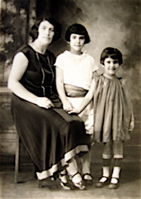
|
From
left: Fanya, Frieda, Mimi.
|
|
Leaving
sweatshops and piece work behind, Fanya
worked at home, in her apartment on
Second Ave., as a private dressmaker.
She also shared the apartment with
boarders to pay the rent. One of them,
a shoemaker with two daughters, was to
become her lifelong partner.
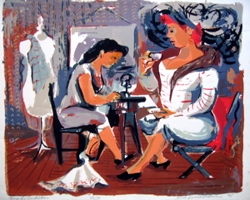
|
“Fanya the
Pinsticker,” 1947.
Serigraph.
Mimi’s memory of Fanya
sewing for a
particularly obnoxious
client.
This print
appeared in an juried
exhibition at the LA
County Museum in 1948.
|
Mimi first studied art at
Washington Irving High School in NYC,
where she hoped to enter the
“lucrative” field of fashion art. It's
possible these samples helped
fill out her portfolio when she went
job hunting:
In the late Thirties and early
Forties, Mimi took classes in drawing,
printmaking, and painting at the Art
Students League and at the American
Artists School, studying with Nahum
Tschacbasov, Anton Refregier, and
Anthony Velonis. She worked as an
artists model to pay her school fees.
In 2006, when I asked her about her
modeling experiences, she sent me this
email:
|
The
Arts Students League’s pay
at 50 cents
was
the lowest rate allowed by
my union, Local 60 of
the
United Professional and
Office Workers,
C.I.O. I
got a
dollar an hour posing in a
studio rented by
three
French sculptors and also
from Willian Zorach,
who
only copied my feet, so I
asked him why I had to
get
naked. He laughed and said
a nude model made him
feel
like he was young, a
student and back in art
school.
Several
evening sketch groups in
private homes paid 75
cents
an hour and The American
Artists’ School gave me
a
dollar an hour credit
towards my tuition. What I
learned
from Anthony Velonis,
Anton Refregier and
William
Gropper was worth a lot
more than that!
An
amusing, touching,
autobiographical short story
she wrote in 1957 reflects
on her experience:
|

Mimi
clipped this photo
for
modesty's sake.
|
|
THE DISARMED VENUS
Time: July, 1936.
Subject: Me, girl graduate,
one of the two hundred odd
High School art Course
diploma holders who had
spent the last three years
singing, along with some
eleven thousand other
inmates, “Good morning, Mr.
Za-brisk-eee, a Washington
Irving Goil am I, oy, oy,
oy!”
Ah! My alma mater. That
venerable, cherished, noble,
all female institution was
situated catercorner to the
somewhat less venerable
Irving Burlesque, wherein
whose hallowed halls Miss
Gypsy Rose Lee daily
exhibited her talents. But
every day as I passed to and
from the stripper’s theater,
I suffered enough shame and
dishonor to compensate all
womankind for the
transgressions of the misled
Miss Lee.
Forty blocks further uptown
stood another venerable
structure, The American
Artists League, far from the
social realities of the
Lower East Side, but also
stacked with great
traditions, and impregnated
with the odors of varnish,
linseed oil, turpentine, and
thickly coated with the dust
of high grade French
pastels.
There was I, unleashed in
June upon one of the leading
cultural production centers
of the world, armed with a
loaded portfolio and imbued
with a strong desire to
delve into the deeper
mysteries of Fine Art. (At
least until job hunting time
in September.)
The problem? Money for
tuition, lack of.
Solution? I filed a request
for a work scholarship, and
then sweated out the days
before the summer session.
When the interview was
granted, there was only a
cursory glance at my
carefully chosen samples.
The questioners were seeking
information about my
physical properties, and I
suffered some prolonged,
pertinent inspection of my
person. But--the board
awarded me a scholarship!
Floating on an airship of Da
Vinci design, I came to the
conclusion that talent,
ability, and sincerity win
out over poverty every time.
Alas, the three virtues had
nothing to do with it. As
the registrar gave me a slip
explaining the nature of my
scholarship, I fell from
space with a flop. My simple
duties, in exchange for the
best available afternoon art
course: ”Pose in the nude,
Rofarge figure sketching
class, 9 to 12 A.M. Room
3A.”
There was a serious
professional model shortage
in the metropolitan area
every July and August. Most
artist’s models, Local 60,
United Office and
Professional Workers of
America, C.I.O., had the
sense and resources to
escape New York City’s heat
and humidity. Since
employment was available
elsewhere, off they would go
to gainfully disrobe in the
pleasant little summer art
colonies of Woodstock and
the New England Coast,
leaving New York City
without figure models,
except for unsophisticated
novices like me.
My first disrobement, before
fifteen friends, strangers,
and fellow students, mostly
fellows, was a troubled,
trembled, never to be
forgotten time of
affliction. I blushed,
perspired, swallowed,
searched frantically for my
hands and feet and a place
to put them, when relief of
a temporary sort came with
the idea that a Martha
Graham type pose would have
such abstract interest, it
would surely negate the
terribly naked reality. So I
struck it.
The students were very kind.
Embarrassed for me. Quiet.
They watched me twist into a
grotesque swastika that even
Hercules couldn’t have held
for twenty, let alone ten,
minutes.
Another scholarship student
and friend, Dave, the class
monitor, looked at his watch
and lost his voice. A few
energetic enthusiasts
rustled their newsprint to a
clean page and started fast,
convinced I couldn’t
possibly last five minutes.
The serious anatomists
worried the charcoal between
indecisive fingers when
Monsieur Rofrage walked in,
stared at me, and loudly
challenged, “WHAT ARE YOU
DOING WITH YOUR BODY?” Dave
whispered that since this
was a first pose, and indeed
my first time as a model, he
had not interfered with my
choice.
“NONSENSE.” But after
considering a moment,
Monsieur softened, and the
French lilt of his voice
dissolved the heavy air.
“Break the pose and rest!
Attention, class. We’ll work
for line, pure pen and
pencil line. No charcoal,
chalk or shading. Ten minute
poses, simple standing poses
for contour and quiet
movement, and PLEASE, design
the PAGE.”
He came to the model stand
and spoke quietly. “Relax
your poses. We want to enjoy
the natural grace of the
human female form. We may
take on the muscles later,
and their varied
manipulations, but for now,
be Venus on the the half
shell, or any of the Three
Graces, just, perhaps,
standing with weight so,
lightly, on one leg.” And he
assumed a stance. I broke
into giggles, tension
released, like a brook
suddenly free of stones. He
looked so funny posing on
the half shell, and he spoke
so sweetly, and he was,
after all, the dearest,
finest, best of all possible
artists, teachers, friends.
I would cheerfully die for
him, contort myself into
knots, half Nelsons, and
double hitches, and all he
asked was an easy pose which
my restless, miserable,
nervous body could surely
hold for FORTY-FIVE minutes,
French model style.
Within ten minutes, sweat
was trickling down between
my arms and sides, and I WAS
dying. My neck was sore, the
muscles aching, the nose
itching, the right ear
twitching, and one leg about
to give way along with my
whole crumbling future. When
Oh! Blessed King David
signaled and called out the
magic word that releases
fair maidens from stone
statue witchery. There is no
more beautiful word in the
English language, none with
a more poetic, ringing
sound, nor half the potency
and meaning. “CHANGE!”
So it went for three long
hours, with five minutes off
every twenty-five, and a
fast fifteen minute break
somewhere in between the
time that didn’t move. But
in that agonizing three
hours there was a quiet
growing. I think I caught a
glimpse of what the Yogi
knows, a satisfaction in the
disciplined control of mind
and body. A model has the
further satisfaction of
knowing how to look at those
who look so piercingly at
her, searching, trying to
learn from her. It was a
good relationship, and there
was nothing immoral about
it. How foolish to have
harbored shame! After all,
what is a body? A source of
education, certainly, and a
source of life. This was a
LIFE CLASS. A class in LIFE.
Dave called the final
“REST.” Oh, the sweet
deliverance! I donned street
clothes in the undressing
room, bounced down three
steps at a time, and strode
through Central Park, a free
and mobile soul. Having
stretched, run, and breathed
deeply, I stopped to sketch
a solitary tree, marveling
at the growth pattern of
trunk into limbs into
branches, then
rejoiced--because the model
wasn’t me!
|
Mimi
joined the Youth Workshop in
the Thirties and traveled with
a group of talented folk in
1939, puppeteering in
Wisconsin and Michigan. She
told me about living on Jane
Street in the West Village in
those prewar days, and running
a soup kitchen to help pay the
rent. Curator Judith E. Stein
describes the times in an
article about the artist Jacob
Landau:
In the late thirties and
early forties, New York was
a crossroads of leftist
culture, bringing together
artists who were passionate
about the labor movement and
politics in general. Landau
was one of the founders of
the Youth Workshop in 1939,
which counted as members
puppeteers, musicians,
actors, and such graphic
artists as Leonard Baskin
and Antonio Frasconi. They
were united by the common
goal of bringing art to the
"people." Ever short of
funds, the Workshop would
host monthly "rent parties,"
where such talented young
people as Zero Mostel, Woody
Guthrie, Pete Seeger, Will
Geer, Canada Lee, and
Leadbelly would offer
entertainment.”
Zuni Maud and Yosl Cutler’s
“incomparable puppets” also
influenced Mimi, with their
performances on the Lower East
Side and in North Branch at a
summer place called "Maud’s
Summer-Ray."
When I mentioned coming across
the familiar names Maud,
Cutler, and Maud's Summer-Ray
in a magazine, she wrote back:
|
Dear Phillis,
You stirred a bunch of
memories. Zuni Maud and Yosl
Cutler painted murals in the
main and children’s dining
rooms that are still vivid
in my imagination. I got to
study them breakfast, lunch
and dinner. They were
clever, vibrant, satirical,
joyous, irreverent and rich
in symbolism. …Until now I
didn’t realize how much I
was influenced by their
work. Those two guys were
multi-talented geniuses in
puppetry and artwork. They
wrote plays, poetry, songs
and comedy... They put
together costumes. They did
opera spoofs way before Sid
Caesar’s T.V. Show of
Shows.
The Modicuts [puppets of the
Modicut Puppet Theater]
included a variety of
puppets and marionettes that
entertained us on summer
evenings with hilarious
skits and dances. Zuni Maud
taught me to play chess when
I was about eight.
[Note from Phillis--he must
have been a good teacher
because Mimi was a
formidable chess player.
Certain men didn’t like
playing chess with her
because they couldn’t handle
losing to a women!] |
Puppetry
became a passion Mimi
returned to when she wrote
scripts for the Lou Bunin
Puppets and, many years
later, when she used
puppetry in Ringwood, NJ, as
a teaching and therapeutic
tool.
|
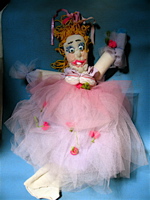
|
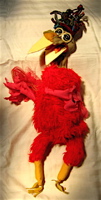
|

|
Ballerina
sock puppet
or, in a pinch, a
Princess.
|
Madame
Cacciatore
(Chicken of the Opera)
and various other
hen-ish
characters.
|
Ghostly
spirit
manipulated
with sock and strings.
|
“Shy
persons,” she wrote in the
1980’s, “can freely express
themselves with puppets, and
puppets can delight even a
depressed or hostile
audience. At the Passaic
County Adult Day Care
Center, an embittered
gentleman in a wheelchair
refused to participate in
after-lunch activities in
the craft room. Fairy
Grandmother Pippette
fluttered toward him on mesh
onion bag wings guided by an
almost invisible discarded
guitar string. Claiming an
ability to grant even
unexpressed desires, she
offered him three wishes. He
looked up but wouldn’t talk
to the puppet, so she
scolded: 'Shame on you! Why
don’t you give me a chance
to prove my worth? Take your
time and think hard about
what you really want, but
don’t be impulsive.
Remember, whatever you wish
can come true. Are you ready
to wish? Do you know for
sure what you absolutely,
really want? OOOPS, too
late! I have to catch my
bus. Goodbye!' Flutter,
flutter. With a sideways
look, the elderly gent made
a halfhearted gesture of
dismissal. 'Get away from
here. You make me laugh!'"
|
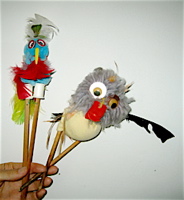
|
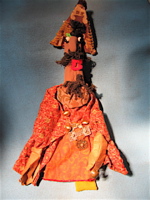
|
Chopstick
bird puppets
made of REAL, if
scraggly,
feathers,
thread-spool thighs,
and various other trash
treasures.
|
Evil
Prime Minister Haman,
from Mimi's retelling of
the Purim
story, which included a
bevy of
bead bedecked belly
dancers.
|
In
the Forties, Mimi received a
lithography scholarship from
Lawrence Barrett at the Fine
Arts Center in Colorado
Springs. Later, in
California, she worked with
printmaker Lynton Kistler.
|
"Scorched
earth," 1943. Lithograph.
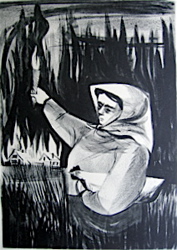
|
"Sedition,"
1947. Lithograph.
Selected for Library of
Congress
National Print Exhibition,
1949.
|
In
1942, Mimi married Morton
Dimondstein, fellow artists
and activist. She followed
him to Colorado Springs
during the war, and to Camp
Adair in Oregon before he
was shipped overseas with
the 104th Infantry Division.
One art project they
collaborated on was a mural
for an artillery division
officers’ club in Colorado.
It no longer exists, but
here's the design sketch:
Mimi also painted a mural
for the USO Kosher Kitchen
in Colorado Springs and
murals for the non-com and
officer clubs at Camp Adair.
I found one of her sketches
for "Three Day Pass," part
of a narrative sequence,
which included a brief, less
than three day, romance:
|
Mimi
moved to Los Angeles to
work. She described her job
to Suburban Trends,
a NJ newspaper (June 8,
1986): “During the war I
worked on airplane
recognition films for the
army. We created animated
films that showed plane
silhouettes so the artillery
would be able to tell whose
planes were passing
overhead, so they wouldn’t
shoot down our planes....”
She also created war related
murals at various sites.
“The murals I did for a
school in LA were
destroyed,” she wrote in an
email in 2006. “The panels I
recall are an African
American woman as Liberty
leading the multinational
people and another of an
integrated group of men and
women architects and
engineers designing the
reconstruction of the world.
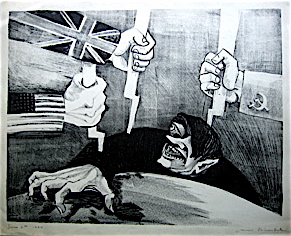
|
"William
Gropper came to
L.A.,
saw
me at work and
remembered
me
as a student in
the American
Artists’School.
He approved and
beamed
paternally.
"A year later, during
the post war era,
the school
was
converted
to
an air
force
academy and the
walls were
repainted."
|
This
lithograph for
D-Day, "June 6,
1944" (above),
reveals
Gropper's
influence on
Mimi's work.
So does
the sketch to
the right.
Warmongers and
profiteering
types populate
many of her
cartoons
and political
paintings.
|
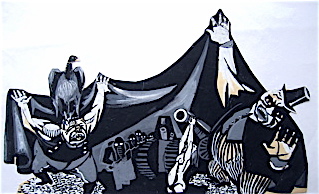
|
After the war, Mimi, Morton,
and Manny Singer opened a
frame shop and gallery in LA
where they sold affordable,
original serigraphs
(silkscreen prints). Mimi
also worked in advertising
and created greeting cards,
in addition to designing and
executing post-war public
and private murals.

|
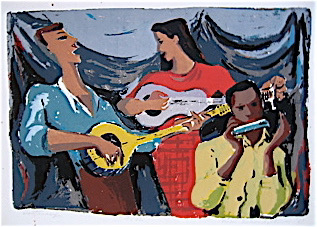
|
"Blues,"
1947. Silkscreen
print.
|
"Hootenany,"
1947. Silkscreen
print.
Pete Seeger,
Sonny Terry, and
Bess Lomax
Hawes.
|
"I was a member of the
screen cartoonists guild for
ten years" in the Forties
and early Fifties, Mimi told
the Suburban Trends,
a NJ newspaper. “In
Hollywood, at the guild, we
were trying to get away from
violence and sex and get
more into
education....” To that
end, she apprenticed with
Graphic Films, did free
lance for TV Spots and Fine
Arts Products, and assisted
Ed Levitt on limited
animation, a technique he
used in the first Charlie
Brown/Peanuts TV
productions.
Mimi wrote
several
autobiographical
poems/ballads.
This one, written in
1979, addresses the
job situation for
woman pre and
post-war:
JOB MARKET
Time was
1936. Place, a city
like New York.
Player is
an art school grad
looking everywhere
for work.
Every art
school student
reaches for the
perfect job to be.
And the
teacher tells us
each is rich in
opportunity.
Then we go
out to the market
and the bubble
disappears
with the
voice of art
directors ringing
loudly in our ears:
“Art is not
the way to go
for a
woman, don’t you
know?
She can sew
and wash the dishes
or
perpetuate the
species.”
I made
lists of every kind
of art work
possibility
from the
yellow pages of the
telephone directory,
wrote my
hopeful letters to a
hundred companies,
clipped the
want-ads and applied
to advertising
agencies.
“Art is not
the way to go
for a
woman, don’t you
know?
She can sew
and wash the dishes
or
perpetuate the
species.”
I pinned my
hair into a bun to
up my age and
dignity.
I walked to
interviews (a nickle
meant a lot to me!).
I applied,
was registered with
every placement
agency,
displayed
my folio to people
who said they’d find
some work for me.
Tried
display and greeting
card, towel design
and children’s toys.
Personnel
was firm and hard:
“We only hire boys.
Art is not
the way to go
for a
woman, don’t you
know?
She can sew
and wash the dishes
or
perpetuate the
species.”
So I wrote
to Mr. Disney,
“California, here I
come!”
And he
answered with a
letter, “East coast
woman, stay at home.
Men are
trained for
animation,
background art and
in-between.
Girls work
here to ink the
cells before they go
onto the screen.
Art is not
the way to go
for a
woman, don’t you
know?
She can sew
and wash the dishes
or
perpetuate the
species.”
Then the
country went to war
and the men in
animation
were all
drafted to make
films that would
help defend the
nation.
Mary Blair
did Disney stories,
and Bernice did
backgrounds for
Warner
Brothers cartoon
features when the
men went off to war.
I did
airplane
recognition,
storyboards and
in-between.
Sterling
Sturtevant was art
director for the
cartoon screen.
Art became
the way to go
for a
woman, don’t you
know?
She could
even work for money
drawing
sequels to Bugs
Bunny!
When we
helped the world
defeat the Fascist
and the Nazi hordes,
G.I.’s came
back to work and
women lost their
storyboards.
We returned
to ink and paint or
out to hunt for work
again
and apply
for better jobs,
just to hear the old
refrain:
“Art is not
the way to go
for a
woman, don’t you
know?
She can sew
and wash the dishes
or
perpetuate the
species.”
She can
breed a little
soldier or another
little breeder
and be glad
she can depend upon
a working man to
feed her.
Now the men
who run the show
tell our children
what to be,
tell them,
“Off to war you go
to protect
democracy!”
And they
build their deadly
weapons with the
taxes that we pay.
Equal
Rights becomes a
slogan for a country
far away.
“Peace is
not the way to go
for a
woman, don’t you
know?
Be a
soldier-bearing
mother
and
exterminate each
other!”
Men who
make rules own women
who will eagerly
assist ‘em,
and they
also own the media
that sugar coats the
system,
but with
songs and art to
teach us, we can
help expose the
leeches
and
together with our
brothers we can
liberate the
species!
The poor job market,
divorce and
remarriage, three
daughters, a move back
to the east coast, and
another divorce and
remarriage slowed but
didn’t stop her
creative output. She
continued to create
artwork in a variety
of genres and styles.
She had a special gift
for seascapes and
animals, and was
inspired to combine
both in several
metamorphic "sea"
horse paintings (an
example on the left):
And she continued to
write stories, novels,
plays, poetry, songs.
To develop her skills,
she took courses in
writing for television
with Walter Hartman at
Brooklyn College,
musical theater with
Aaron Frankel at the
New School for Social
Research, and
playwriting with Jan
Hartman at the
Circle-in-the-Square
Theater School. Her
song lyrics reflected
a love of language and
rhyme. At times she
liked to "improve" on
classics, revising
them or adding her own
verses. Her addition
to "Amazing Grace,"
for example, can be
found in the Folk
Process column of Sing Out
magazine, Volume 64, #
4, pages 54/55.
It was a real
privilege having such
a creative mom, who
could make
personalized paper
dolls for us, board
games like “Fate” and
“Big Game,” and
birthday cards
listing, in rhyme, our
accomplishments. She
influenced,
encouraged, and
inspired our own
creativity, too. When
I started writing
books for children,
Mimi became my
sounding board--and
often my collaborator.
One of the stories we
wrote together, a
bedtime book for
preschoolers titled Who’s
Awake in
Springtime?
(Holt), is
delightfully
illustrated by the
talented French
artist, Emilie
Chollat, and was a
children's
book-of-the-month club
selection for February
2010. She did the
illustrations for The
Fisherman's Horn
(Campana), which I
completed. Another
young picture book we
had collaborated on, Time for a Hug
(Sterling),
with
adorable
illustrations
by David Walker, came
out in January 2012,
in time for National
Hug Day!
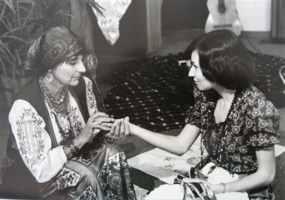
|
Here's a
photo of Mimi
as a gypsy at
an event in
NJ, reading
fortunes for a
good cause no
doubt. A
corner of the
board game
"Fate," which
she devised,
is visible.
Actually, she
found she was
so accurate at
palm reading,
it gave her
the willies,
and she gave
up readings
forever. It
wasn't the
palms so much,
although a
worn or even
smooth hand
can reveal a
lot, it was
the expression
in the
eyes,
mouth....
A
selection of
game card
designs for
"Fate":
|

|
|
Mimi was observant. As
a portrait painter she
had to be. She was
exceptionally good at
the quick and telling
sketch. She did five
minute, ten minute,
thirty minute sketches
at fairs. Watching
artists plying that
skill in a NYC park
recently made me think
of the hundreds of
sketches she gave away
and sold, not to
mention all the
sketches of musicians
she did when she went
to music festivals and
concerts, and of
community activists
when she went to
meetings. She did
sketches (for
publication) of
attendees at the
historic San Francisco
conference in 1945, a
series in the 1980's
of illustrious women
such as Margaret
Sanger, and of course,
many sketches of
family members
throughout the years.
Here, from left to
right, are sketches of
Mimi's mother in 1956,
a self portrait in
1947, and Mimi's first
born in 1942.
She worked most often
in pen and ink,
watercolor, oil, and
acrylic. When she
visited Italy in 1984,
she returned to
printmaking, building
on her earlier success
as a young
lithographer. She
produced a number of
lithos in Florence,
which were drawn on
Bavarian limestone and
printed by Tamara and
Raffaello Becattini of
Edi Grafica Printers.
In a postcard she
wrote, “I am on a roll
creatively. After
years of somnolence,
the stuff is busting
out!” She also worked
on stone at another
prestigious studio, in
Milan, and was very,
very excited about the
piece, but the stone
was completely
destroyed (on account
of its political
content she
suspected), and though
she was offered a
replacement stone, she
lost, for a time, her
high spirits and
momentum.
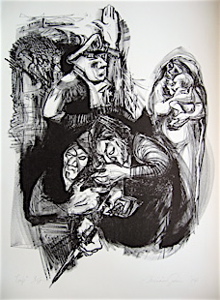
|
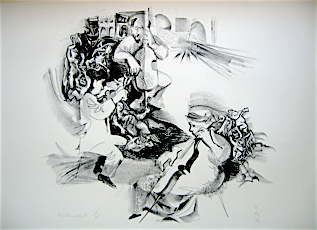
|
“Coup,”
1984.
Lithograph
which received
first prize in
graphics at
the Ringwood
Manor
Arts
Association
19th Annual
Exhibition. |
"Three
Musicians,"
1984.
Lithograph
conceived as a
memorial
to her late
husband, Sol
Green, with
whom she
enjoyed
countless
concerts.
|
She also tried
her hand at
another
graphic
technique,
etching, but
the themes she
approached
were so
painful, one
influenced by
Kathe Kollwitz
and others by
the news of
famine in
Africa and the
coup in Chile,
that she found
she was
unconsciously
grinding her
teeth to bits. |
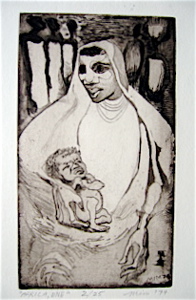
|
After that, as she
told her oldest
granddaughter, she was
ready to turn to
flowers--
cheerful florals in
watercolor.
Mimi was
enthusiastically
involved in so many
things! A passionate
gardener who loved to
study seed catalogs
and plants, especially
herbs and their
healthful properties;
a great cook who
invented her own
recipes, taking Adele
Davis to heart early
on; an
environmentalist and
recycler who served,
for example, on the
Borough Conservation
Commission in
Ringwood, NJ, and
chaired the local
League of Women Voters
environmental quality
committee; an active
demonstrator, petition
signer, check signer,
and
letter-to-the-editor
writer when it came to
social justice and
progressive causes;
and a teacher, on both
the east and west
coast, from her
teenage years on into
her 70’s, of art,
puppetry, and dance in
schools, summer camps,
and senior centers.
Yes, dance, too, on
top of everything
else! In her youth,
Mimi studied dance for
over a dozen years
with such teachers as
Alyse Bentley, Pauline
Koner, Nadia
Chilkosky, and
Gertrude Knight.
I still remember the
dance classes she
conducted in
California--we
children were seeds.
We sprouted, we grew,
our branches reached
up to the sun.... We
were also the wind,
rain, snow.... I was
reminded by an old
family friend that, in
our post-war San
Fernando Valley tract
house, we didn’t have
much furniture in the
living room, but we
did have a ballet bar.
Mimi’s publications
include artwork and
articles in the NJ
magazine “Talking
Wood,” co-authorship
of Who’s Awake in
Springtime?
(Holt) and Time
for a Hug
(Sterling),
illustrations for Honi’s
Circle of Trees (Jewish
Publications Society), I See
America Dancing
(Aries Acres, IA), Between Day
and Night (in
Yiddish, Harlick
Press, LA), Elegy for
Val and Bang Bang
Lulu (both
X-Press Press, NY), The Fisherman's Horn (Campana), The
Big Roar (Campana),
and greeting cards for
Brownies Blockprints
(NY) and Fraymart
Gallery (CA), in
addition to her
lithographs, etchings,
and silkscreen prints.

|

|

|
Silkscreen
print
greeting cards
from the mid
1940's.
|
She exhibited her work
under her mother’s
abbreviated maiden
name, Login, and her
own married names:
Dimondstein, Cohen,
and Green, until
she finally signed
herself, simply, MIM.
Her artwork can be
found in private and
public collections and
has been exhibited in
“one man” and group
shows at, among
others, the Library of
Congress National
Print Show, Brooklyn
Museum National Print
Show, Raymond and
Raymond Galleries
(CA), Fraymart Gallery
(CA), Institute of
Modern Art (CA),
Ringwood Manor (NJ),
Valley Center for the
Arts (CA), Ringwood
Public Library (NJ),
Oakland Art Show (NJ),
First Unitarian Church
(CA), LA County Museum
Print Show, Salem USO
(OR), Irving Savings
and Loan Association
(NJ), New Jersey “Fall
Open” Print Division,
and Island Galleries,
St. Thomas
(USVI).
Mimi was always a
great letter writer,
sharing news about her
garden, books she’d
been reading, current
events, meals and
recipes. She always
added a few newspaper
clippings and cartoons
with her letters, and
she freely and
frequently dispensed
her philosophy of
life, in which JOY
played a big part. In
1943, she wrote to her
mother: “In only one
way could my love and
respect and pride in
you be made any
deeper. And more
important, this one
way would make you
healthier, happier,
and give you a greater
joy out of a longer
life. It is to stop
worrying needlessly.”
“I want you to enjoy
life, so please forgo
anxiety,” she wrote me
forty four years
later. “Do it to make
me happier. I know it
will be a wrench to
part with worry, but
you must give it a
shot. Think of all the
positive, creative
things you can put
into a mind when you
put out the
negatives.”
In one missive, she
spelled out her wishes
for a memorial, which
her daughters
attempted to carry out
to the letter when the
time came (including a
good approximation of
the ample and detailed
menu she suggested):
“My wishes in the
matter of my
departure: get
together to tell funny
stories about me and
to remember all the
good times. Eat well
and play my favorite
music. Dance. Do NOT
make speeches but you
might read a poem or
two. Enjoy each other.
Sing. Play guitars.”
In
future,
we will add more of
Mimi's poetry and
prose to these pages,
plus examples from her
hundreds of cartoons
on love, music, dance,
food, law, war.... We
welcome input from
friends and family,
too.
|
|
|
|
|
|
|